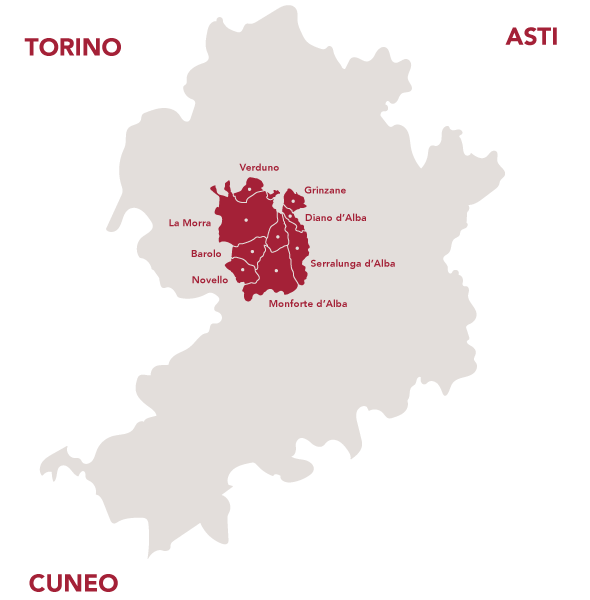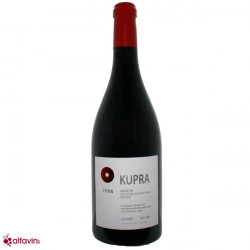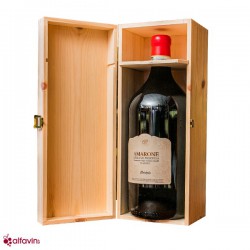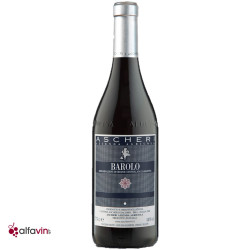What is a Super Tuscan?
Known mainly for its Chiantis until the 70s, Tuscany experienced a real wine revolution when Marchesi Antinori bottled his first 'Tignanello'. Composed of a blend of 80% Sangiovese 15% Cabernet Sauvignon and 5% Cabernet Franc, this wine was a real upheaval and questioned the established order. Indeed, the rules of the DOC appellation of the Chianti zone were, at that time, extremely restrictive. The blend could only contain a maximum of 70% Sangiovese and a minimum of 10% of another white grape variety. International grape varieties were totally forbidden and any producers who derogated from these rules could not mention the name of Chianti and had to classify their wine as "Table wine".
During this period, the Tuscan winemakers came to realize that the rules governing the Chianti appellation were too restrictive and therefore decided to start developing and marketing new types of wine that challenged regional traditions and regulatory requirements! It was only a few years later, in the 1980s, that the term Super Tuscans was invented and used to describe a very high quality red Tuscan blend of international grape varieties such as Merlot, Cabernet Sauvignon and Syrah. The term "super-Tuscan" is not an official designation and will not appear on the bottle; you will have to look for the classification "Toscana IGT" appearing on the label! Note that there are IGT wines from all over Italy! And the idea is the same: to use a variety of indigenous and non-native grapes! The most prestigious wines can benefit from the designation "Bolgheri DOC Superiore" or even "Bolgheri Sassicaia DOC" for Sassicaia.
Download our free Super Tuscans guide.
How to discover Italian wines?
Italian vineyards are the oldest in the world. The Greeks gave the territory the nickname of Œnotria meaning "the land of wine." According to the OIV, Italy is today the world leader in wine production, ahead of France and Spain. The peculiarity of Italy: all regions of the country produce wine: from Veneto to Sicily via Sardinia. The climate in general is Mediterranean, although the north and the centre are rather temperate. The variation in terrain is very different from one region to another, as much as culinary cultures or grape varieties (nearly 340 officially). This geographical, climatic, cultural and ampelographic diversity makes this country a mosaic of amazing richness.
Summing up, Italy can be subdivided into three major wine regions:
- The North, with Veneto to the east, the birthplace of Amarone and Prosecco, and the regions of Trentino and Friuli, producing wines of an "alpine" style. To the west: a varied geography, encompassing more alpine regions such as Valle d'Aosta and Lombardy, hilly regions such as Piedmont (Barolo) and Emilia-Romagna with Lambrusco, then Liguria to the south and Cinq Terres coiled along the Mediterranean.
- The Centre, on the west coast, the beauty of the hills of Tuscany (Bolgheri and Chianti), gives way to Lazio (Rome). In its heart, Umbria and the mountains of the Apennines, leaves place on the Adriatic Sea to the regions of Marche, known for its organic farming, Abruzzo, known for their Montepulciano and Molise, just above the spur of the boot.
- The South, finally, is another country: Campania (Naples, Amalfi, etc ..) on the west coast, Puglia on the east coast, Basilicata in the centre of the two, then Calabria, wild and amazing. The two islands of Sardinia and Sicily, with varied terroirs, complete the South of Italy.
In general, we can say that Tuscany, Piedmont, Veneto and Puglia are the most recognized regions for their wines. The fact that the first three (Piedmont, Tuscany and Veneto) are the regions of the country that gather the most DOCG is certainly not strange.
Discover the best Italian wines in Switzerland.
How to choose your Italian wine?
In essence, we can say that the more we go south of the country, the more the wines tend to soften. Indeed, it is generally accepted that southern wines have less bitterness, less acidity and have more body than their more northern cousins. Conversely, the closer we get to the north, the more we can find fine and fresh wines, with delicate notes and sometimes with more marked tannins. For example, Piedmont and its Barolos - Barbarescos will satisfy the most demanding palates. Tuscany, for its part, has proven that it can produce wines of rare elegance with impressive ageing potential.
However, throughout Italy, many winemakers go off the beaten track and manage to produce beautiful wines by making the most of their terroir. In the South, for example, there are some terroirs providing fine and crafted wines (Taurasi, Etna, etc.) with producers able to produce exceptional wines. Similarly, in the North, some producers have been developing for decades powerful and sweet wines (Amarone della Valpoliccella, Moscato d'Asti) sought after by amateurs in many countries.
Therefore, it is true that for the unsuspecting amateur, finding a wine that will please his budget and his guests can be a challenge. Especially when you are in a supermarket aisle with no sales people in the late evening.
To help you, there are fortunately passionate and dedicated wine merchants who will help you choose your wine according to your tastes, your meal and your budget. Another practical and comfortable solution exists for a few years now in order to discover new wines: tasting boxes. At home, with friends or as a couple, you receive and discover wines at your own pace according to your budget and your preference. The tasting boxes come with technical sheets, enabling you to discover and accompany your meals or your evenings.
Discover our favorite Italian wines online.
What are the main Italian wines varietals?
Italy is today the world leader in wine production, ahead of France and Spain. The peculiarity of the country: all regions (20 in total) produce wine: from Veneto to Sicily via Sardinia. With as many regions as culinary cultures, Italy is a mosaic of colours and flavours. How could it be otherwise for the varieties of the peninsula: with more than 340 grape varieties officially listed (initially, the country would have counted more than a thousand grape varieties), more than 70 DOCG and 300 DO, the country is bubbling with diversity . Within this variety, a large part of the grape variety is of indigenous origin, as far as can be said (because it appears that the origin of many Italian grape varieties is found in neighboring countries, on the other side of the Adriatic).
Most grape varieties have adapted very well and established themselves in their region to become closely linked to their terroir (eg. Nebbiolo in Piedmont). Others, like Sangiovese, are planted in several parts of Italy, but especially in Tuscany in the Chianti region. Today, Sangiovese represents 10% of the vines of the country and expresses itself in very different ways according to the terroir.
The most common varieties of the main regions (non-exhaustive list):
- Abruzzo: Montepulciano, Trebbiano
- Calabria: Magliocco, Gaglioppo
- Campania: Aglianico, Piedirosso, Casavecchia, Greco, Falanghina, Fiano
- Marche: Montepulciano, Sangiovese, Pecorino (white)
- Piedmont: Nebbiolo, Barbera, Arneis, Dolcetto
- Apulia: Primitivo, Negroamaro, Nero di Troia, Susumaniello, Malvasia Nera, Aleatico
- Sicily: Nero d'Avola, Grillo, Grecanico, Nerello Mascalese, Frappato, Catarrato
- Sardinia: Cannonau, Vernaccia, Vermentino, Bovale, Carignan
- Tuscany: Sangiovese, Vermentino. And the following grape varieties that go into the production of Super Tuscan - Cabernet Sauvignon, Cabernet Franc, Merlot and Syrah
- Veneto: Corvina, Corvinone, Rondinella and Molinara for the production of Amarone. Glera (Prosecco), Raboso, Refosco del Peduncolo and Trebbiano
What is the origin of Barolo, the King of wines, the wine of Kings?
"King of wine, the wine of Kings".

Until the middle of the 19th century, wines produced in the Barolo area were rather mild. The climate and vigor of the winters prevented the fermentations from being pushed to the end, leaving residual sugar behind. In the 1830s, at the instigation of Camillo Benso, Count of Cavour and Giulia Colbert Falletti, the last Marquise of Barolo, great efforts were made with the help of external advisers to raise the quality of the wines produced.
With its great qualities, the Barolo quickly became Piedmont's ambassador in all the European Royal Courts. He becomes the "King of wine, the wine of Kings".
The Barolo area is located in the Langhe hills between the Alps and the Apennines. The name Langhe, seems to come from a term of Celtic origin which means "tongue of land" by referring to the shape and layout of the various hills and deep valleys of the region.
To obtain the name Barolo DOCG, the maximum yield per hectare is 56 hectoliters, strictly from the Nebbiolo grape variety. This name comes from the Italian word Nebbia which means fog, simply because the Nebbiolo is harvested relatively late, when the first fogs of autumn appear. The ageing in wood must last at least 2 years and at least one year in bottle. For the Riserva versions, the ageing must last at least 5 years in total, including 3 years in wood.
Download our free Barolo ebook.
By the way, how is Amarone produced?
Amarone is obtained mainly from grape varieties such as Corvina, Corvinone, Rondinella and Molinara. It is harvested relatively early, at the beginning of September, and then dried in racks or boxes for about 4 months sheltered from the wind and rain. During this time, the water contained in the berries evaporates and only the natural substances of the grapes remain with a high concentration. After pressing and fermentation, the wine is aged for at least 2 years in barrels and casks of oak, cherry and chestnut, in order to reach its undisputed character.
The story of Amarone is very interesting. In the past, this region produced only Recioto, a sweet red wine, whose fermentation was interrupted to leave residual sugar. But one day, an owner came back too late to his property and the fermentation had been completed. While tasting the wine, he said "Ma, è amaro", which means, "But, he is bitter". This anecdote is an explanation of the origin of the wine and its name "Amarone".
Amarone comes from the region of Verona in Veneto. There are two production areas. The classic area in the hills of Marano, Negrar and Fumane and the new area of the plain ... The real quality Amarone comes only from the vineyards of the Classico area, which gives the name to the appellation Amarone Classico della Valpolicella DOCG.
Let it be clear, a real Amarone is not sweet! It is rich, intense, fruity (stewed fruit) and complex. It will go perfectly with your meals from the hunting season, red meat and cheeses. Cheers!
Discover the best Amarone wines in Switzerland.
What is Prosecco?
Prosecco is a sparkling white wine made from Glera grapes.
Prosecco is produced according to the Charmat method. After the first fermentations in still wine, the bubbles are produced in closed tanks under pressure. This method is different from that applied to champagne (traditional method), with the bubbles taking place in the bottle.
Several factors come into play to produce a high quality Prosecco. This is what the producers Setteanime do to produce Prosecco Extra Dry DOC:
- The yield in the vines: maximum production authorized by the appellation is 180 quintals per hectare. Setteanime limits to 150 quintals per hectare to obtain the best quality of grapes.
- The Selection of musts: Setteanime only keeps the best during pressing ie. the first press (55% of the yield) with the rest being sold to the local cooperative. This operation keeps the freshness and the primary notes of fruit in the Prosecco. It should be noted that the average yield obtained by producers is 73%.
- The grape variety: finally, Setteanime only uses the Glera grape. The appellation authorizes a maximum of 15% Pinot Noir or Chardonnay to be included.
Conclusion: Prosecco can be a quality product. Unfortunately, too often customers neglect the quality aspect in favour of the price element in the purchase decision. Even in a Spritz, we would like to drink the best ingredients, surely?
Discover one of our best Prosecco wines delivered in Switzerland.
What is the difference between Primitivo and Zinfandel?
The name of this iconic grape variety literally means "primitive": because of its very early maturity, it is still the first red to be harvested and flourishes in very sunny and warm regions. In some places, it can even give two crops. Native to Apulia, but originally from Croatia according to DNA tests, it is also present in California under the name of Zinfandel. The grape variety expresses itself in different ways according to the appellations: it produces rather fresh or dry wines in the DOC Gioia del Colle appellations and rather powerful and expressive wines in the DOC Primitivo di Manduria appellation. Sometimes accompanied by a few grams of residual sugar, this variety is particularly appreciated for its intense fruitiness and roundness.
Discover Italian Primitivo in our online store.
Are there quality Italian wines and how to find them?
Wine production, like any agricultural production, can be summed up in two types of philosophies and / or economic concepts. Industrial production will seek to promote economies of scale, by mechanizing the vineyard and cellar activities as much as possible and by using synthetic products to reduce costs. On the contrary, the artisanal production will rather favor the soil and the authenticity while respecting the environment. The artisan will produce wines that will vary according to the climatic conditions of each vintage. A product of nature!
As a result, often, but not always, the price can be an indicator of wine quality. It is clear that artisanal work, in small production, with lower yield and manual labor will produce first quality wines and be representative of the work of the artisan winemaker and its terroir.
In Italy and Spain, there are two types of philosophy. At alfavin.ch, we favour artisans by promoting their work and their production. So how to choose your wine and pay a fair price for good quality? Ask our specialists, who will be happy to explain the differences between producers, regions, grape varieties, vintages, etc.
Are you able to store Italian wines?
Let's start by twisting the neck of an old belief that Italian wines do not keep over time!
There are several factors that come into play in the ageing potential of a wine. These factors are the acidity, the tannins, the material, the terroir, the balance and the know-how of the winemaker.
In Italy, we find all these qualities in all wine regions. The new technologies and know-how of winemakers coupled with the quality of soils, grape varieties and climates give plenty of examples, such as Barolo, Amarone, Super-Tuscans, Taurasi, Turriga, Kurni, Patriglione, etc ...
Ask your wine cellar for advice or take a look at our older Italian vintages.
Discover also our wine subscriptions to offer as gifts or for yourself.
Hoping to count you among our Italian wine lovers on alfavin.ch
Our wines linked to this post
- Highlight










